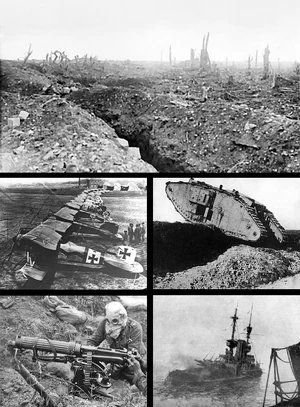The First World War is not known as the Great War for no reason. It was the bloodiest and most brutal conflict in history up to that point. The First World War was fought on every continent but Antarctica. Te Great War was a revanchist conflict for many nations. The Americans wanted to conquer their northern neighbors, the Canadians, and the northern rebels, the Federal States. To France and Italy this was a time to regain Alsace-Lorraine, and to gain Trieste and parts of the Alps. The Great War impacted every single nation on the planet. The Great War would claim the lives of some 40 million people (about three times as OTL WWI did). Fighting was raged from Alaska to Middle East. Many ethnicities would be exploited for the war effort either by conscription or labor.
The overall course of the war was a slow slugging match between the Entente and the Concord. Trench warfare would dominate the battlefield. Trenches would stretch across continents. In America the trenches stretched from the Rockies to the Atlantic. In South America the Trenches stretched from the Andes to Buenos Aires. In Europe, Belgium to the Adriatic. The countries of the world fought with all their might and the soldiers with all their fury. Many nations would collapse under many pressures, Either the nation didn't have enough industry or was overwhelmed by the sheer numbers of men their enemy was throwing at them. WWI was known by many names. The Great War, the War to end all Wars, the catastrophe, la Guerra, der Weltkreig.
The war would change how people fight wars and develop weapons and technology. Weapons would be invented to kill millions of men. The slow bolt-action rifle would be fazed out for semi-auto rifles and sub-machine guns. The horse would be fazed out for the tanks. Air combat and reconnaissance shaped the battlefield. Gas would be used on mass in Europe and America. Poison gas would be used for the rest of history as a great way to clear out tunnels and buildings.

